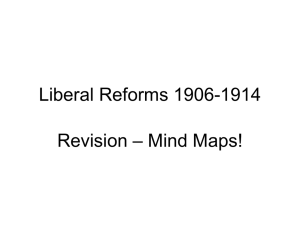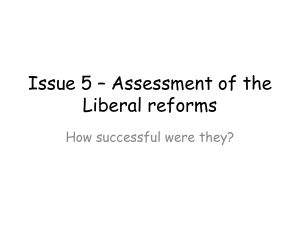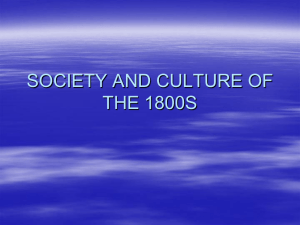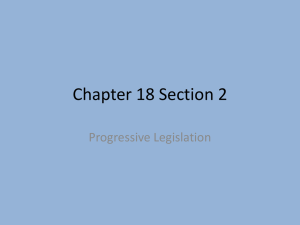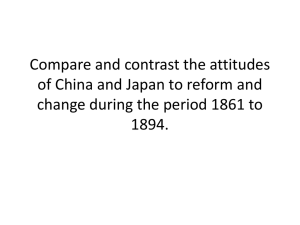The Liberal Reforms Recap
advertisement
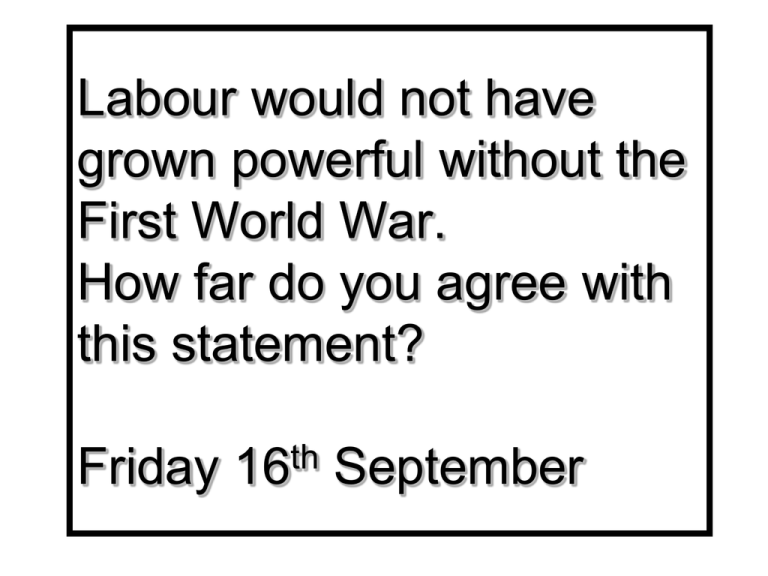
Labour would not have grown powerful without the First World War. How far do you agree with this statement? Friday th 16 September How successful were the Liberal reforms? What? An evaluation of the Liberal Reforms Why? The Reforms have been seen as the birth of the Welfare state. Were they really? Was it a welfare state? What is a Welfare state? Be ready with a definition of this The idea of comprehensive social services and social security provision Past paper essay questions How far were the reports on poverty produced by Booth and Rowntree responsible for the Liberal social reforms of 19061914? (2005) To what extent did the social reforms of the Liberal government (1906-1914) improve the lives of the British people? (2006) Fear for Britain’s place in the Evidence of poverty (Booth and Rowntree )was widely read. This was inescapable evidence world - national security. When potential recruits tried to join the army for the Boer War (1899), almost 25% were turned down on the grounds of poor health WHY did the Liberal Government pass reforms? “New Liberals” -had new ideas on state intervention. National Efficiency – Britain no longer the top industrial nation. Belief that this was connected to poor health and educational standards. Chancellor Bismarck’s social reforms were making Germans strong in comparison. Political pragmatism – Liberals could lose votes to Labour if nothing was done to help the poor. 1906 General election 377 seats (Tories 157, Labour 29) Ended long period of Tory dominance Tories lost it because of Boer War and failing education and tax systems Liberal success the result of individuals..... Henry Campbell Bannermann Prime Minister 1906-1908 Retired from ill-health and died a few days later Key reformer Herbert Asquith Chancellor of Exchequer 19051908 Prime Minister 1908-1916 David Lloyd George Chancellor of Exchequer 19081915 Winston Churchill Left Conservatives in 1904 Home secretary 1910-1911 Lord of Admiralty 1911-1915 Edward Grey Foreign Secretary 1905-1916 Longest continuous holding of office in British History Their reforms This section is about their reforms. There is little value in simply reciting the reforms in an essay. You need to be able to explain how and why this form of Liberal welfarism was different from the ideas of Laissez Faire. What were the reforms about? Aimed at helping people who faced poverty through no fault of their own: Young people Old people Sick people Unemployed people Reform area Young Old Sick Unemployed Other Reforms 1906 - Free school meals for young people… Success Failure Young 1906 - Free school meals for young people 1907 – School medical inspections started 1908 – juvenile courts / borstals started Children’s charter restricted the sale of alcohol and cigarettes How effective were these reforms? Research showed that growth of poor children slowed during school holidays. This showed that school meals were an important part of health of poor children. Medical inspections did little to solve any problems discovered Attempts to protect children from smoking and alcohol had limited success. Old 1908 – government started paying 5 shillings (25p) per week to people over 70 who had a current income of up to £21 per year A married couple got 37.5p each week Less pension given to higher earners How effective were these reforms? Providing pensions is the basis of a Welfare state. But remember, Rowntree calculated a poverty line for an individual to be 35p a week. Old age pensions therefore helped the elderly but did not solve old age poverty Many elderly people needed help long before they reached 70 and most died before receiving a pension. Sick There was no free National Health Service at the time The poor could not usually afford treatment 1911 National Insurance Act gave some medical benefits Every worker contributed 4p per week towards medical help Every employer then added 3p and the government added 2p per week. Called ‘nine-pence for four-pence’ How effective were these reforms? Illness and absence from work were a major cause of poverty. So money coming in as ‘sick pay’ did help families in hard times. However, only the insured worker got free medical treatment from a doctor. Other family members did not benefit from the scheme, no matter how sick they were. Unemployed Labour Exchanges (like today’s job centres) were started. Part II of the NI Act dealt with unemployment and workers paid into the scheme and got contributions from their employers and the state. How effective were these reforms? The 1911 act only covered temporary unemployment Also only applied to seven trades When unemployment increased after WW1 the system failed as too many people claimed benefit and there was not enough money to pay out. Other reforms worth noting You should add these if a question asks about Liberal Reforms in general 1908 miners act secured an 8 hour day (first time the length of a working day was fixed) 1909 Trade Boards Act protected ‘sweated trades’ such as tailoring. These fixed minimum wages and maximum hours 1911 Shops Act gave shop assistants a weekly half day off Assessment The liberal reforms were more important psychologically than anything else They set precedents for future reform They did not improve much for ordinary British citizens The idea of comprehensive social services and social security provision Positves? If we compare them against the old Victorian ideas of self-help and the poor-law then the Liberal Reforms mark a Giant step . They paved the way towards the later proposals of the welfare state which WAS set up later in 1945-1951 Essay Question: Did the Liberals create a Welfare state? NO It was a transition point between old laissez-faire attitudes and what was later called the Welfare state A change of ideas but still wanted the poor to help themselves Liberal MP Winston Churchill “If we see a man drowning we do not drag him to the shore. Instead we provide help to allow him to swim ashore himself.” The Liberals tried to help poorer sections of society to help themselves. The Reforms were not always successful Tasks 1. Complete all work up to and including page 38 2. Create a table about the Liberal reforms and their success. Complete it using the statements on page 39 3. Copy the diagram on page 39 and add detail to it using the textbook pages 48 to 57 as well as slide 1. Arguments for the success of the Liberal Reforms Arguments against the success of the Liberal Reforms Etc……. MINI ESSAY In your opinion, were the liberal reforms successful in creating a welfare state? Write a detailed answer with evidence to back up your argument.
